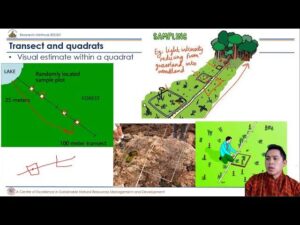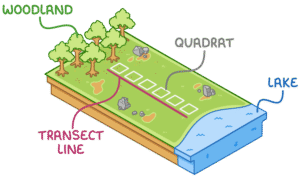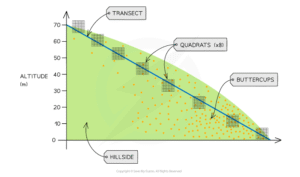Back to: ZOOLOGY 500 Level
Welcome to class!
Hello brilliant mind! It’s always a pleasure having you here. Today’s lesson is going to be very practical and useful, especially if you’re planning to conduct fieldwork soon. We’ll be learning about quadrat and transect methods—two simple but powerful tools that ecologists use to study plants and animals in their natural environment. Let’s break it down together in a way that makes perfect sense for you as a Nigerian student.
Quadrat And Transect Methods
What is a Quadrat?
A quadrat is a square frame, usually made of wood, metal, or plastic, that is placed on the ground to mark off a specific area for study. Within that square, you can count the number of species, measure their sizes, or estimate how much space they cover. Common quadrat sizes include 0.5m x 0.5m or 1m x 1m, depending on what you’re studying.

Imagine you’re trying to study the grass and weeds in a school field in Ilorin—you can’t count everything! But with a few quadrats placed randomly, you can get a good idea of the species that are present and how they’re spread out.
What is a Transect?
A transect is a straight line—usually a rope or measuring tape—that you stretch across a habitat. You then observe and record species that occur at intervals along that line. It’s especially useful when you’re studying changes in species across different environments, like from a riverbank into dry land.
For example, if you’re studying how plant life changes from the edge of River Kaduna into the nearby farmland, a transect line helps you track that gradual change in vegetation clearly.
Types of Transects
Line transect: You record species that touch the line directly.

Belt transect: You place quadrats at intervals along the line to record species in a wider strip.
How to Use a Quadrat and Transect Together
You can combine both methods to get more detailed information. Stretch a transect line, and then place quadrats at regular intervals (e.g. every 5 metres). In each quadrat, you record the types and numbers of species. This gives you a clear picture of how organisms are distributed across the study area.
Why These Methods Are Useful
They help researchers:
Study biodiversity and abundance of species
Track changes in ecosystems over time
Make comparisons between different habitats
Work in a systematic, repeatable way

Real-Life Example
Tunde, a Zoology student at the University of Ibadan, wanted to compare plant diversity in a grazed and ungrazed grassland. He used a 20-metre transect line and placed a 1m x 1m quadrat every 4 metres. In each quadrat, he counted the number of plant species and recorded their frequency. His data showed that overgrazed areas had fewer plant species, and the soil was more exposed. This helped him recommend better grazing management to the local community.
Summary
- A quadrat is a square frame used to study species within a defined area.
- A transect is a line used to record species at intervals across a habitat.
- Both tools help scientists understand species distribution and abundance.
- They are simple, effective, and very useful for ecological fieldwork.
Evaluation
- What is a quadrat used for in ecological studies?
- Explain how a transect works and when it’s best used.
- What is the difference between a line transect and a belt transect?
- Describe a situation where you would use both quadrat and transect methods.
You’re doing so well! Understanding these tools brings you closer to being a confident, skilled ecologist. Whether you’re in a forest in Cross River or studying plants in your school compound, you now have the knowledge to work smart and make a difference. Keep pushing forward—Afrilearn is with you every step of the way!
